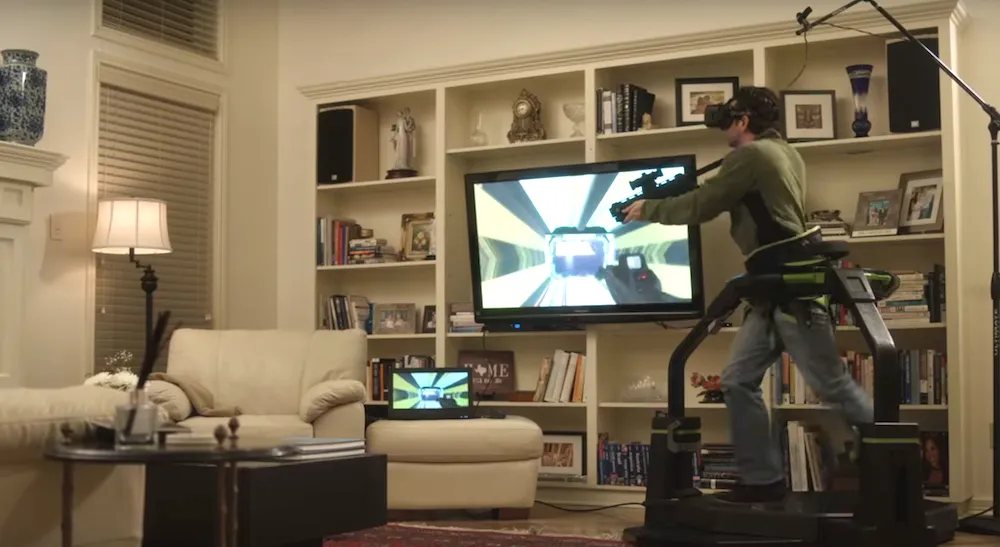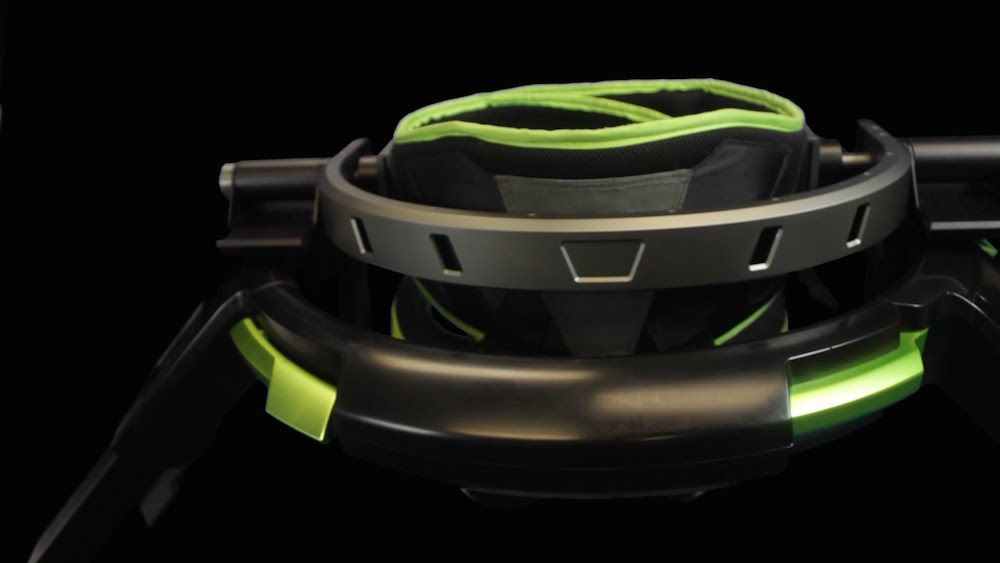At GDC 2016 I had the chance to try the “Pathfinder” edition of the Virtuix Omni VR treadmill. Following the demo I spoke about ergonomic improvements, shipping dates, and available content with the onsite company representatives.
The Oculus Rift ships in three days. When this happens the conceptual era of virtual reality will come to an end and the commercial age will begin in ernest. This is an enormous moment for Oculus, but it is just as significant of a moment for the VR industry in general which contains much more than just headsets.
The Omni has mirrored the life cycle of the Rift in many ways. Both were Kickstarter success stories at around the same time; both are almost completely unrecognizable in their current form when compared to their prototypes, and – as I learned at the show – both are expected to be in consumer’s hands by the end of this year.
Virtuix’ communications manager Lorenzo Adams confirmed after my demo that his company is currently in the process of shipping the unit I tested – known as the “Pathfinder” – to a slew of beta testers. After this focus group’s feedback on the device can be recorded, Virtuix will make the necessary improvements before ultimately shipping the final consumer version – known simply as the Omni – to the more than 5,000 customers that have already placed a pre-order for the $699 system.
“We’ve shipped over 30 units to our beta testers and we’re planning to send out more after GDC,” Adams said from the show floor. “…We’re targeting a Q3 launch date for the final version. However, that could change depending on what we find during the Beta and our own QA tests.”
The Pathfinder is already a dramatic improvement over the Omni’s earlier incarnations. Ergonomically, Adams highlighted the harness and ring system that now eschews the previous rock-climbing style and instead, “wraps around your legs instead of your crotch. This has been far more comfortable for people especially those who use the system for an extended period of time.”
The redesigned harness wasn’t exactly comfortable, but it was far from a painful or agitating experience.
My brief five minute play session with the Omni was certainly good if not completely great. The harness didn’t quite stabilize my center of gravity which made it tough to move for too long in any direction without stumbling. Their was also a slight – but still noticeable – amount of input lag that detracted from the experience as well. However, the moments where I had my momentum locked into that sweet spot were some of the most immersive and enjoyable VR experiences I’ve had to date.
Increased comfort isn’t the only new addition to the Omni’s trademark “ring” configuration.
“Sensors in the ring itself now track your movements,” Adams said. “This allows for decoupled movement…basically you can now walk and look in two separate directions. You can also walk backwards and strafe from side to side.”
The Omni is a self-described treadmill, but unlike the traditional mat and roller design of a standard treadmill, Virtuix has created frictionless shoes that slide over the curved bowl-like plastic bottom of the device while the harness keeps your body in place.
The motion’s of your feet are tracked by the only piece of true high-end technology that this system incorporates: two sensors that clip directly onto those special shoes. The rest of the treadmill is a relatively low-tech hunk of metal and plastic that mostly exists simply to keep you locked in place.
Despite the simplicity of the Omni’s concept, it still commands a hefty price tag. At $699 the Omni costs more than the Rift headset it would be an accessory for and almost as much as the HTC Vive headset that was running during my demo. Adams understands that this price point may be a turn-off to potential customers:
“Every year I build a computer and I see the prices go down for parts almost as soon as I’m finished. We’re going to get to the point where this becomes more affordable for the average consumer. But until then I do see this as more of an enthusiast product.”
One thing that may convince you to take the $699 plunge is the breadth of content that the Omni is compatible with. By translating your foot movements with its sensors and emulating them as controller inputs into a computer, the Omni becomes a viable option for almost any PC game. This, plus single-USB and bluetooth connection options, means that the Omni is a relatively plug and play option for a litany of video games beyond dedicated VR titles.
“In fallout 4 I walked across the entire wasteland,” Adams recalls. “The Omni can work with almost any video game. The bigger limitation is whether or not the headsets can.”
https://www.youtube.com/watch?v=4UfZ_0yCBxM
According to Adams, if a user is able to acquire a program – such as My Dream Swift or Big Screen – that allow traditional games to run in VR headsets, then there is no reason why that game can’t be played with the Omni.
Assuming that the final version tackles the few issues I experienced during my demo, I see no reason that the Omni can’t serve as the premier solution to VR’s limited locomotion problems. Investors seem to agree with that sentiment as well.
Adams’ final revelation at the show was that Virtuix has garnered $30 million of “indicated investor interest” on SeedInvest. This interest is not a concrete figure by any means, but it was enough to convince the company to open its currently ongoing series A round of fundraising.
https://www.youtube.com/watch?v=k_q2zGywt4U





























